Estimated reading time: 14 minutes
Discover how a Chinese tea ceremony promotes health and mindfulness through art, culture, and tradition.
This blog post explores the richness of ancient traditions through a tour of two Chinese tea houses in Hainan, China.
Table of contents
Tea Tasting Experience
A friend of mine recommended a tea tour in Hainan, China. She connected me with a family who owns several tea houses in the region and invited me on a tour of two of the most famous tea houses in the area.
From the moment we arrived, I was struck by the beauty and tranquility of the tea gardens surrounding the tea houses. The sweet, floral scent of the tropical plants wafted through the air, and I couldn’t help but feel a sense of calm wash over me.

Each tea house we visited had its unique atmosphere and charm, with traditional Chinese culture found in every corner.
I was immediately transported to a different world as we entered the first tea house. Traditional Chinese decor adorned the walls, and the delicate aroma of freshly brewed tea filled the air.

At the first tea house, we learned about the region’s famous Pu Erh tea, a worldwide popular among tea connoisseurs. The tea was brewed with precision and care, and the rich, earthy flavor was unlike anything I had tasted before.

We were introduced to the complexities of black teas renowned in the region at the second tea house.
As we sipped on fragrant teas, our guide shared stories about the region’s tea culture and the ancient traditions that are still strong today.

The tea business owner, our guide, explained the science behind the tea’s production, and we had the opportunity to taste several varieties. The bold flavors and aromas left a lasting impression on me.
Learning about tea production led to a newfound appreciation for the artistry and skill in each cup of tea.
I couldn’t help but feel inspired by the passion and dedication of the tea business owner and our host, who have dedicated their lives to sharing the beauty and complexity of tea with the world.
As the tour ended, I felt deeply grateful for the opportunity to learn about the science, art, and culture of tea in China. It was an unforgettable experience that gave me a newfound appreciation for this beloved beverage.
Traditional and Contemporary Chinese Tea House Design
While there are differences between traditional and modern Chinese tea house decor, both styles emphasize creating an atmosphere conducive to the enjoyment of tea.
- In terms of colors, traditional Chinese tea houses typically feature a more muted color palette, with shades of brown, beige, and red dominating.
- Modern tea houses, on the other hand, feature brighter colors and bolder patterns.
Whether traditional or contemporary, Chinese tea houses are places where people come together to relax, connect, and appreciate the beauty and complexity of tea.
Traditional Chinese Tea House
A blend of classical and cultural elements typically characterizes the decor of traditional Chinese tea houses.
These tea houses feature ornate wooden carvings, elegant calligraphy, and traditional Chinese paintings on their walls.

The furniture is made of high-quality wood and includes wooden tables, chairs, and benches.
The lighting is often dim and ambient, creating a serene and peaceful atmosphere conducive to relaxation and reflection.
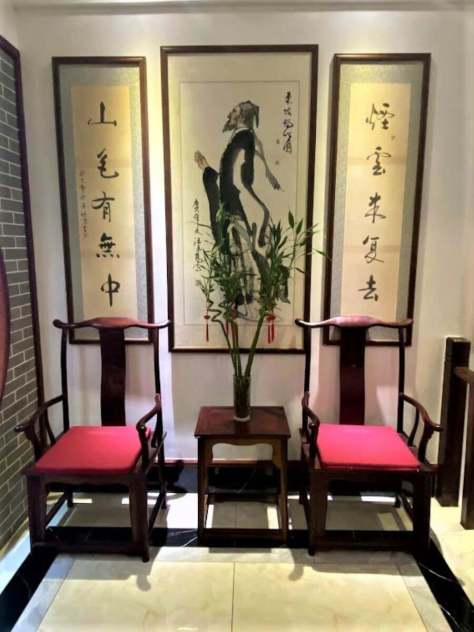

Contemporary Chinese Tea Houses
Modern Chinese tea houses feature more contemporary decor.
The designs are minimalistic and sleek, with clean lines and simple shapes.
The lighting is usually brighter and more modern, focusing on creating a bright and inviting atmosphere.
Furniture is made of more modern materials like metal, plastic, or glass.



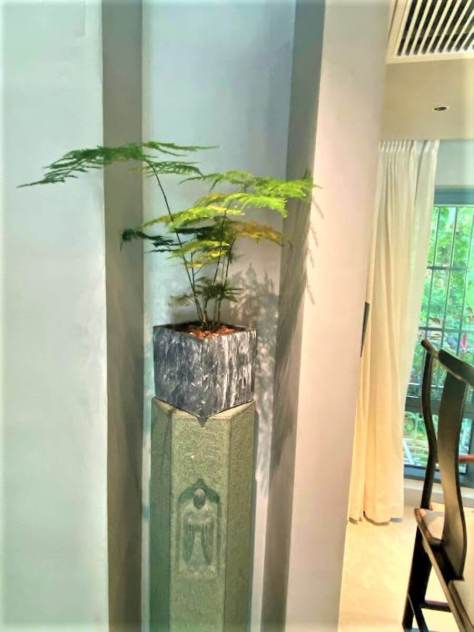


Chinese Tea Ceremony
The traditional Chinese tea ceremony (传统中国茶艺表/ chuántǒng zhōngguó cháyì biǎoyǎn) is a time-honored ritual practiced for centuries.
It brings people together to share tea’s beauty, elegance, and spirituality while appreciating the art and culture of tea.
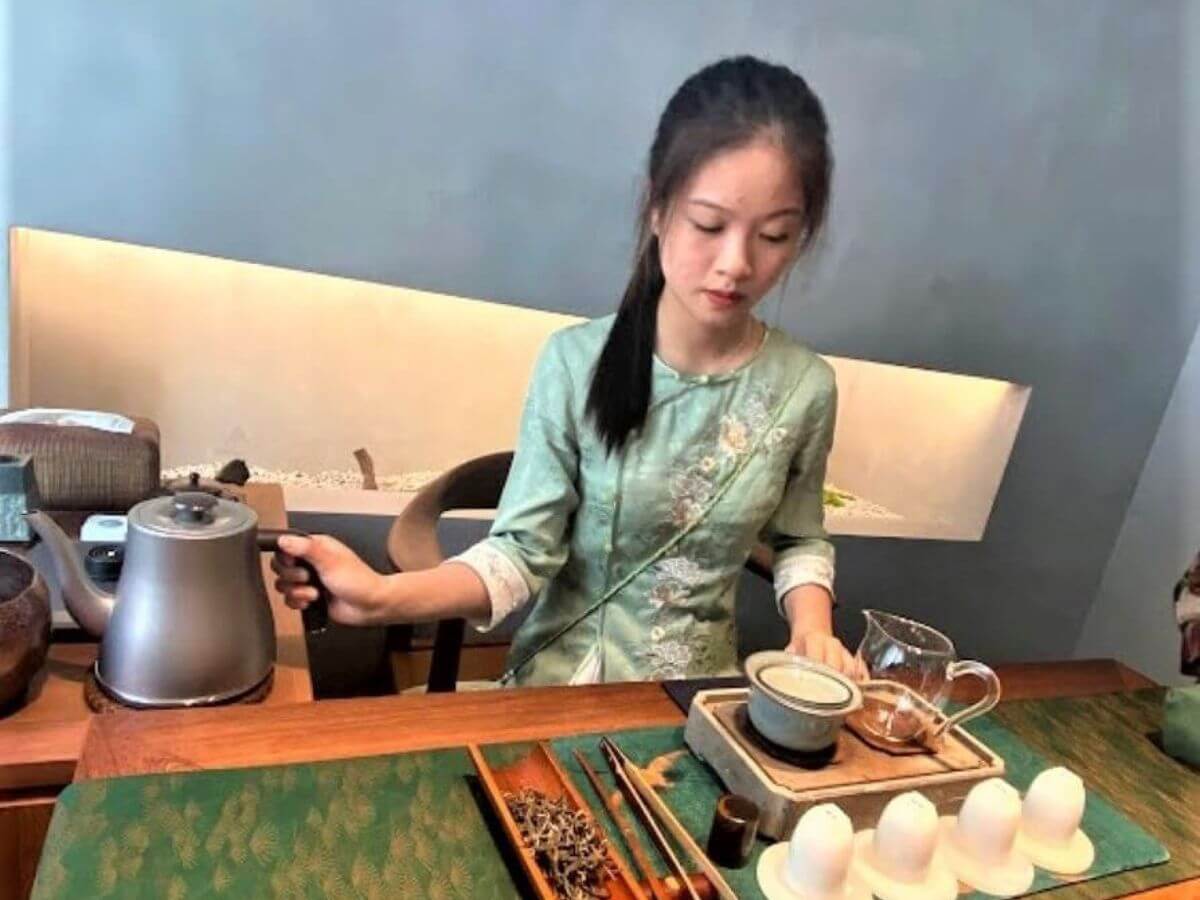
Chinese Tea Ceremony Process
Preparing tea in the Chinese tea ceremony involves careful attention to detail and an appreciation for the tea’s natural flavors.
- The ceremony starts with selecting a high-quality tea, which is then carefully measured and placed into a teapot.
- The teapot is rinsed with hot water, then filled with hot water, and allowed to steep for a few seconds before the water is poured out.
- The first infusion of tea is then poured into a pitcher, which is used to distribute the tea evenly among the guests.
- The tea is then poured into small cups, and each guest takes a sip, making sure to appreciate the aroma and flavor of the tea.
During the ceremony, the host will perform a series of graceful and intricate movements, such as pouring the tea in a circular motion or holding the teapot at a certain angle.
These movements are not just for show but are part of the ritual of the ceremony, designed to enhance the flavor and aroma of the tea.
Here’s a video of the tea ceremony process from our Chinese tea house tour:
Tea Ceremony Rituals in China
The Chinese tea ceremony is about drinking tea and cultivating a sense of mindfulness and appreciation for the natural world. It is a way of connecting with others and nature’s beauty and harmony.
In Chinese culture, slurping when sipping tea is not only accepted but is also encouraged. It is considered an essential part of the tea-tasting experience, as it allows the tea drinker to fully appreciate and savor the flavors and aromas of the tea.
During a Chinese tea ceremony, the host prepares the tea carefully.
- When it is ready to be tasted, the guests are encouraged to take a deep whiff of the tea’s aroma before taking a small sip.
- As the tea passes over the tongue, the drinker slurps it into their mouth, aerating it and allowing it to reach all parts of the mouth.
This technique not only enhances the tea’s flavor but also helps to cool it down, making it more enjoyable to drink.
As a Canadian, I was initially surprised by this practice, as I had been taught that slurping was considered rude in our culture. However, as I learned more about the Chinese tea ceremony, I came to appreciate the reasoning behind the slurping.
Slurping is a way to show respect for the tea and the effort that went into preparing it.
By fully appreciating and savoring the tea, we better understand and enjoy its taste, aroma, and cultural significance.



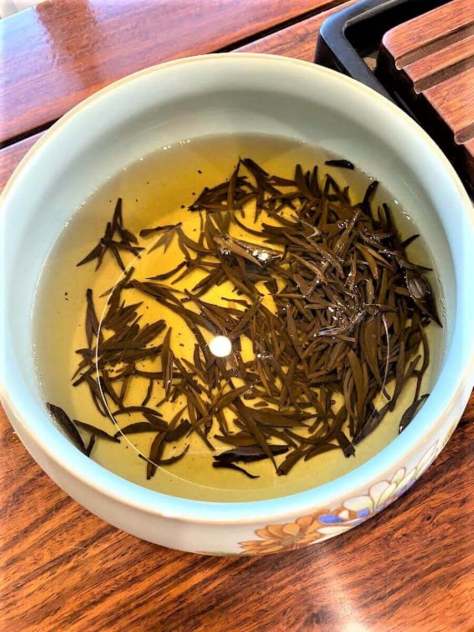
Cross-Cultural Tea Rituals
The traditional Chinese tea ceremony and the British high tea merge in appreciation of tea, conversation, and snacks, but there are several notable differences between the two.
First, the atmosphere of the two ceremonies is vastly different.
- The Chinese tea ceremony emphasizes tranquility and serenity, focusing on meditation and relaxation.
- In contrast, the British high tea is a more social affair, with lively conversation and often served in a more formal setting.
Second, the tea itself is prepared and served differently.
In the Chinese tea ceremony, the tea is typically served in small, delicate cups and brewed in small quantities, with great attention paid to the quality and temperature of the water, the steeping time, and the presentation of the tea leaves.
On the other hand, British high tea often involves teapots, larger cups, and a variety of tea blends, emphasizing quantity and variety rather than the presentation of the tea leaves.
Lastly, the accompanying food served during the two ceremonies is quite different.
- The Chinese tea ceremony focuses on the tea itself, with a few small snacks like fresh nuts and small cookies served to complement the tea’s flavor.
- In contrast, British high tea often includes an array of sweet and savory foods such as scones, sandwiches, cakes, and pastries.
Despite these differences, the traditional Chinese tea ceremony and the British high tea offer a unique and enjoyable tea-drinking experience that has been cherished for generations.



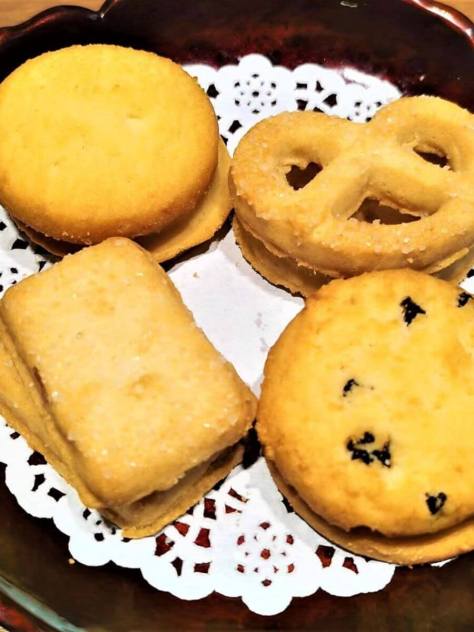
Tea Varieties in China
- Green Tea 绿茶 (Lǜchá): Light, refreshing, and slightly bitter with grassy notes.
- Black Tea 红茶 (Hóngchá): Rich, bold, with a hint of sweetness.
- Oolong Tea 乌龙茶 (Wūlóng chá): Complex, floral, and fruity, with a smooth finish.
- Pu-erh Tea 普洱茶 (Pǔ’ěr chá): Earthy, musty, with a hint of sweetness.
- Jasmine Tea 茉莉花茶 (Mòlì huā chá): Fragrant, sweet, with a hint of floral notes.
- Chrysanthemum Tea 菊花茶 (Júhuā chá): Light, floral, slightly sweet.
- Dragonwell Tea 龙井茶 (Lóngjǐng chá): Nutty, sweet, with a hint of chestnut.
- Tie Guan Yin Tea 铁观音茶 (Tiěguānyīn chá): Floral, with a hint of orchid and honey.
- Keemun Black Tea 祁门红茶 (Qímén hóngchá): Full-bodied, with a hint of smokiness and fruitiness.
- Huangshan Maofeng Tea 黄山毛峰茶 (Huángshān máofēng chá): Sweet, with a hint of floral and fruit notes.
Health Benefits of Tea
There are many health benefits associated with drinking Chinese teas.
Here are some examples:
- Antioxidants: Chinese teas are rich in antioxidants, which help to protect the body from free radicals and prevent cell damage.
- Digestive Health: Many Chinese teas, such as pu-erh and oolong tea, aid digestion and promote healthy gut bacteria.
- Weight Management: Some Chinese teas, such as green tea and pu-erh tea, have been shown to boost metabolism and aid in weight management.
- Mental Health: Chinese teas are often used in traditional medicine to promote mental clarity, calmness, and relaxation.
- Cardiovascular Health: Chinese teas, mainly green and black tea, have been shown to help lower blood pressure, reduce cholesterol levels, and improve heart health.
- Immune System Support: Chinese teas, such as chrysanthemum tea and goji berry tea, contain immune-boosting compounds that can help to protect against illness and disease.
Overall, drinking Chinese tea is a beneficial addition to a healthy lifestyle.
Summary
My experience with learning about the traditional Chinese tea ceremony has been truly enriching. I have gained a deeper understanding and appreciation for this practice’s cultural significance and intricacies.
The tea ceremony is about drinking tea, creating a harmonious environment, and fostering community.
The rituals involved, such as the careful preparation of the tea and the specific ways it is poured and served, all enhance the sensory experience and promote mindfulness.
I have learned that the tea ceremony is not only a reflection of Chinese culture but has also influenced and been influenced by other cultures throughout history. It is a practice that continues evolving and adapting to modern times while maintaining its core values and traditions.
Overall, I feel grateful for the opportunity to learn about this fascinating and beautiful art form. It has given me a greater appreciation for the complexities and beauty of traditional Chinese culture, and I look forward to continuing to explore and learn more in the future.
Thanks for stopping by!
Until next time,
Suzanne


You must be logged in to post a comment.